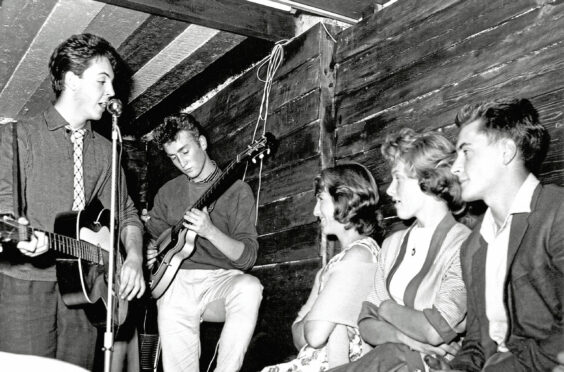
It was a typical church fete, an event found in towns and villages all over the country that summer.
In a field behind St Peter’s Church, in Woolton, Liverpool, was the usual selection of craft and cake stalls, while the entertainment came from a police dog demonstration, the crowning of the Rose Queen, music from a local skiffle band made up of schoolboys who called themselves The Quarrymen, led by singer and guitarist John Lennon.
The group arrived on the back of a lorry. Lennon’s younger half-sister, Julia Baird, was among those watching and described the scene, saying: “The boys were up there on the back of the moving lorry trying to stay upright and play their instruments at the same time. John gave up battling with balance and sat with his legs hanging over the edge, playing his guitar and singing. He continued all through the slow, slow journey as the lorry puttered its way along. I leaped alongside the lorry, with our mother laughing and waving at John, making him laugh. He seemed to be the only one who was really trying to play and we were really trying to put him off!”
That evening the group was due to play again, and while setting up to play, their tea-chest bass player Ivan Vaughan, introduced the band to one of his classmates from Liverpool Institute, the 15-year-old Paul McCartney.
The pair chatted for a few minutes, then McCartney showed Lennon how to properly tune a guitar – the Quarrymen’s guitars were in G banjo tuning.
McCartney sang Eddie Cochran’s Twenty Flight Rock and Gene Vincent’s Be-Bop-A-Lula, then a medley of songs by Little Richard.
Speaking to Record Collector magazine in 1995, McCartney said: “I remember coming into the fete and seeing all the sideshows. And also hearing all this great music wafting up from this little Tannoy system. It was John and the band.
“I remember I was amazed and thought, ‘Oh, great’ because I was obviously into the music. I remember John singing a song called Come Go With Me. He’d heard it on the radio. He didn’t really know the verses, but he knew the choruses. The rest he just made up himself.
“I just thought, ‘Well, he looks good, he’s singing well and he seems like a great lead singer to me.’ Of course, he had his glasses off, so he really looked suave. I remember John was good. He was really the only outstanding member, all the rest kind of slipped away.”
Lennon was equally impressed with McCartney, particularly with his natural singing ability.
The pair then played on the piano together, and McCartney and the Quarrymen then went to the pub together, lying about their ages to get served.
Later, Lennon and Quarrymen washboard player Pete Shotton – the pair had been friends since they were six – discussed inviting McCartney to join the band. Lennon was in two minds – should he allow an equally talented player into the group who would pose a challenge to his own superiority? But in the end, it was decided to approach McCartney.
Two weeks later, Shotton encountered McCartney cycling through Woolton. McCartney agreed to join, beginning a journey which would lead to the formation of the Beatles and the most successful song-writing partnership in history.

Enjoy the convenience of having The Sunday Post delivered as a digital ePaper straight to your smartphone, tablet or computer.
Subscribe for only £5.49 a month and enjoy all the benefits of the printed paper as a digital replica.
Subscribe